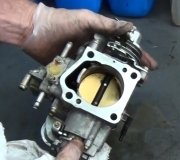Start by checking for vacuum leaks. The Engine Computer will try to correct the resulting high idle speed which can bounce around.
If no leaks are found, you'll need a scanner that displays live data to see what the computer sees and what it is trying to do. In particular, check the reading from the coolant temperature sensor and ambient air temperature sensor. When a sensor is failing, which is rare, their readings can bounce around but as long as they stay within 0.5 to 4.5 volts, no diagnostic fault code will be set.
Also look at the automatic idle speed (AIS) motor to see which "step" the computer has set it to. Step 32 is typical for a warmed-up engine. If the step listed is lower when engine speed is higher, the computer is trying to lower it without success. If the step is higher when engine speed is higher, the computer is reacting to an incorrect sensor signal.
Wednesday, January 4th, 2012 AT 10:55 PM



